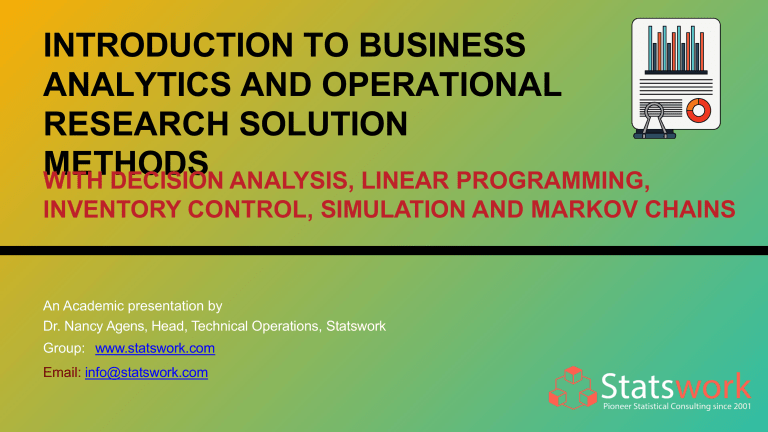Introduction to Business Analytics and Operational Research Solution Methods - Statswork
advertisement

INTRODUCTION TO BUSINESS ANALYTICS AND OPERATIONAL RESEARCH SOLUTION METHODS WITH DECISION ANALYSIS, LINEAR PROGRAMMING, INVENTORY CONTROL, SIMULATION AND MARKOV CHAINS An Academic presentation by Dr. Nancy Agens, Head, Technical Operations, Statswork Group: www.statswork.com Email: info@statswork.com TODAY'S DISCUSSION Outline of Topics Introduction Business Analytics Benefits of Business Analytics Goals of Business Analytics Markov chain Example Conclusion Introduction There is a growing demand in the field of business analytics. It actually means that what outcome we should get in business from the data to make better decisions. This is often sound like relating a business problem to an operation research problem. The meaning of business analytics and uses of the operation research methods or decision making including linear programming, inventory management, simulation and Markov chains are explained here. Business Analytics Analytics are used to identify (i) what has happened? (ii) What should happen? And (iii) what will happen? In the business. These three forms of question are categorized into Descriptive, Prescriptive and Predictive analytics respectively. Business analytics is the study of data via statistical techniques, constructing predictive models, implementing the optimizing rule and draw a valid inference according to the business needs. Thus, business analytics uses a huge amount of data or simply big data to make a profitable conclusion. Benefits of Business Analytics Business analytics is used to implement the data mining techniques such as classification, regression analysis, clustering analysis, etc., and to understand the complex data using neural networks, deep learning and machine learning techniques. Business analytics is used to do quantitative statistical analysis or solving a mathematical model to deliver justifications for the occurrence of the problem. It can be used as a supporting tool for conducting any multivariate testing and A/B testing to find the relationship or test the relationship with past decisions. It can be used for predictive modelling to improve business standards. Goals of Business Analytics The main goal of business analytics is to identify which dataset will be useful and how it can be taken forward to solve the business problems and increase the profit, productivity, and efficiency. In recent years, business analytics in operational practice has become a great interest among researchers. With the growth of technologies, and with the large amount of data at hand, it is important to make use of analytics and the operation research approach to solve many complex business problems. Markov chain Example Consider a bank which deals with both asset and liability products, and it is obvious that loans taken from the bank play a vital role in the revenue. The bad loans and the paid-up loans are the absorbing nodes or the end state in a Markov chain. The absorbing node is that it has no transition probability to any other nodes. So, as a statistical consultant, the first step is to understand the trends in the loan cycle with the previous study. Contd.. Figure 1. Markov Chain for pattern of loans Next step is to calculate the transition probability matrix with the previous probability. Estimate the number of loan which belongs to each category. From the diagram, it is clear that 60% has good loans, and 40% has bad loans. Thus, the calculation becomes, Contd.. From the final output, it is expected that 15% of the loans are going to be paid-up loans for the current year and 16% becomes a bad loan. The retail industry can develop their business insights to decrease the percentage of bad loans in the future. In addition, if you want to predict the same for 2 years, it is calculated as Contd.. Similarly, the process is repeated until the convergence is achieved. That is, From the convergence result, it is identified that 54% of the present loan will be paid fully, and 46% will be a bad loan. Contd.. If you want to identify the proportion of good loans becoming a paid loan, then you should start with 100% of good loans and others as 0% in the initial stage and repeat the process until convergence is achieved. From the results, it is identified as only 23% becomes a bad loan whereas in the previous case it was recorded as 46%. Conclusion Operational Analytics or business analytics involves building a suitable model or developing a predictive model to make meaningful business decisions. It may be a transportation model, or the Markov model, or the Linear programming model or a simulation model; the objective is to satisfy the business needs and do a profitable business. CONTACT US UNITED KINGDOM +44-1143520021 EMAIL info@statswork.com INDIA +91-4448137070

